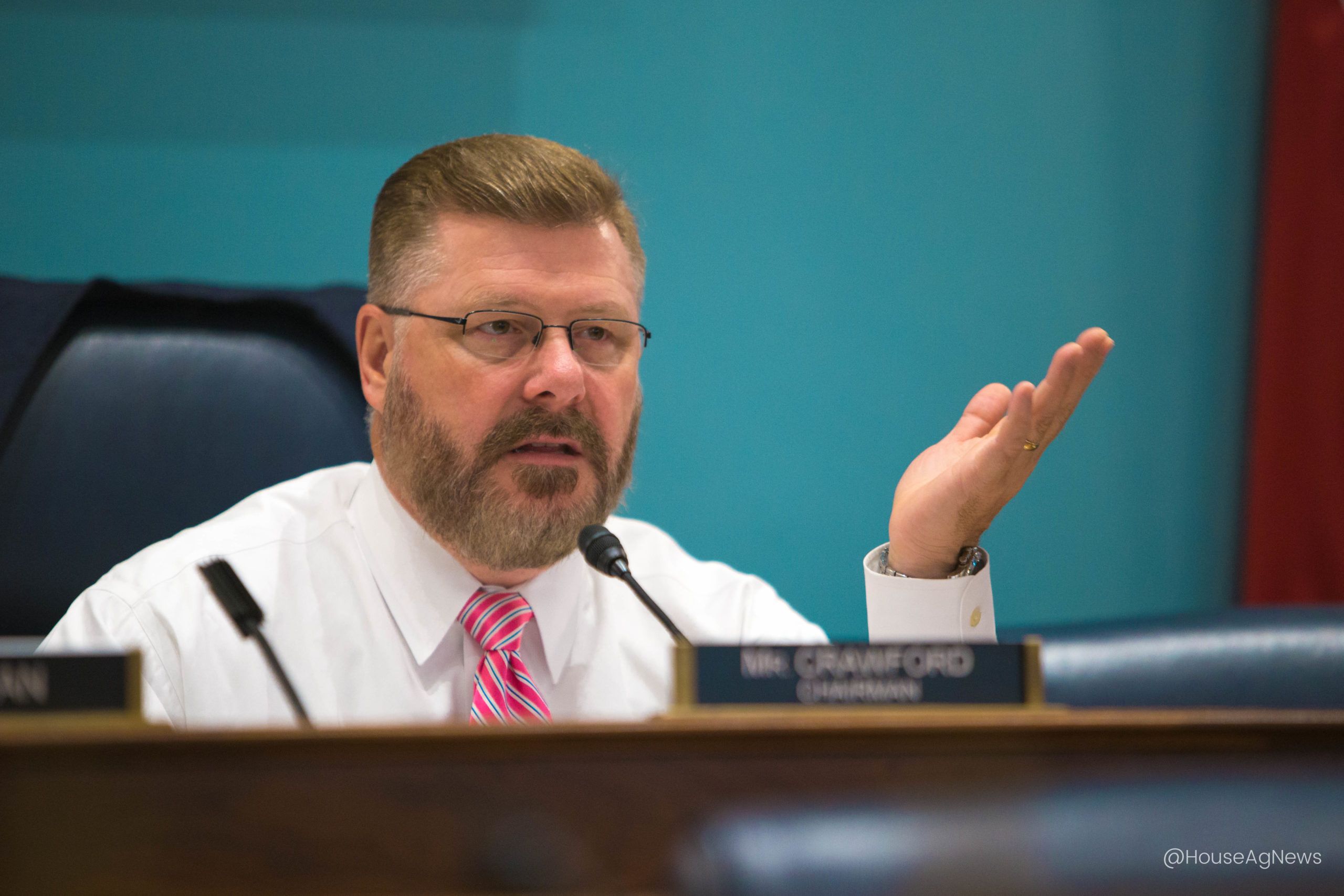The state of Arkansas is home to Tysons, Walmart, a Nestle plant and a Frito-Lay factory, but much of the food produced in Congressman Rich Crawford (R) of Arkansas’s first district is grown on family farms. According to Crawford, his district supplies about half of the rice grown in the US. The state is number one in the country for rice production and number two for broiler chickens, so it’s no wonder that Crawford sits on the House Agriculture Committee and chairs the Subcommittee on General Farm Commodities and Risk Management. Crawford recently led a hearing on technology and data in agriculture in preparation for drafting the next Farm Bill, coming in 2018.
We spoke to Crawford about what role, if any, technology will play in the next Farm Bill, the issues surrounding big data technologies in rural farming communities, and a few local issues in Arkansas.
How will technology be integrated into the farm bill in ways that it didn’t four years ago?
I don’t think we’re going to have a technology title per se, but I think what we’re looking at is reviewing technology: how we implement it in policy development. One of the things that came up today in our hearing was being able to streamline these programs at the (Farm Services Agency) FSA office and how the producers interface with those programs. I think we’re going to be looking at opportunities to incorporate technology and improve services. And I think what the federal government needs to do mostly with regard to technology, is get it out of the way and let it happen. I think that what you’re seeing in the marketplace is that it has the ability to meet the demand out there. The government’s role in that regard is mostly to make sure that folks are playing by the rules and that producers aren’t being taken advantage of. But, the government should create a favorable environment for those technological advances to take place.
One of the most interesting parts of the hearing today was around crop insurance and how technology can make that whole system more efficient and more accurate. Do you think there is a role for the federal government to play in integrating some of the existing digital agtech out there into crop insurance assessment and reporting since the government is such a huge stakeholder in that whole ecosystem?
I think obviously the government plays a role in that at this point in time. The question is going to be how much of a role will the government continue to play and for how long? And can we rely on technology to help bridge that gap? In the short term, certainly yes, the federal government is going to be involved and continue to be. In the long term, technology could make it much more favorable for the government to limit the role that it plays, and then rely more on the marketplace. None of this is going to change markedly overnight, but I do think we’re on a path to a greater reliance on technology and less reliance on government.
Let’s move on to broadband. It seemed at the recent hearing as if both the representatives and the private sector witnesses were looking at each other asking “What are you going to do about it?’ How do you think the rural broadband issue gets tackled and who makes the first move?
Well, one of the questions asked was how much will it cost? And so far, nobody knows. And so I think there has to be some consideration there because regardless of what role who plays, whether we’re going to rely on the federal government for this, or whether we’re going to rely on the private sector, we still need to get our arms around what this is going to cost because as I said in the hearing, I believe this is like a three-legged stool. One leg is the technology that changes quickly, so there are going to have to be rural telecoms, ideally, but not necessarily rural. Then we have the infrastructure. Who’s got the infrastructure? Who’s got access to these rural areas? And the third leg of that stool is finance. Who’s gonna pick up the tab and how? Are we going to do a public, private partnership? You can’t bond this out in rural communities because you don’t have the population to pay that back. We’re going to have to have probably some sort of public, private partnership. Who’s going to step up and do that? We don’t really know.
All we’re hearing is rhetoric in the private sector and rhetoric at the federal level. It’s the next challenge for the 21st century, just like rural electrification was for the 20th century. I think the time has come to stop talking about it and actually figure this out. And the first step is can we get some estimate of what it’s going to cost so when we start talking about this investment, we can put a dollar figure to it? We do know that per person it is going to be considerably more expensive than it would be for broadband in major metropolitan areas. That is an issue and those are things that, as technology continues to advance, maybe that cost curve bends down in a more manageable way. But we first need to know in real-time today what it’s going to cost to connect rural America.
Could you ask that question, fund that research, and get that answer through the farm bill?
Sure! And I think that is probably going to come to fruition and that probably is the extent of the federal government’s role at this point beyond what’s already there in terms of rural utilities. We probably do need to put a provision in the farm bill to do some kind of a study so that we can know just exactly how much it would cost in 2018 dollars to connect rural America and then go from there. And then once we have a fairly good ballpark figure, then we can take that three-legged stool I mentioned before and start to engage those players. And as I said, I’d like to see the federal government play less of role in these kinds of things, but we can’t rely 100% on the private sector on this because I think the cost of this is going to be so much that there is going to need to be some federal help. But I do think there is potential for non-federal dollars at the state level and for private investment.
It seems like you have two major food players in your state that would have a vested interest in spreading broadband through rural communities. Do you talk to the big ag and food players in your state about this issue?
I talk to anybody that is interested. Obviously, I have an interest in my district, in my state. But I have an interest in rural America and I represent a rural district. And in spite of the fact that we have the metropolitan area of Little Rock and Northwest Arkansas which is home to Walmart and Tysons and a couple other industries, we’re still a decidedly rural state. If you think about North Dakota, South Dakota, Montana, Wyoming, these are states that have a similar dynamic. We want to make sure that these folks that live down in Dumas, Arkansas have the same advantages that they would have in Little Rock or maybe St. Louis or Memphis.
We talk to a lot of startups and agtech companies for whom their physical hardware is quickly democratizing and so the value right now for precision agriculture is in that data and the analytics that they can draw from it. Today’s hearing made it very clear that farmers are suspicious about data ownership and controlling their data. How do you think we mitigate this friction and keep technology moving forward?
Well, I think you have to bring it down to the turnrow level and you have to instill confidence in the producers. There are very valid privacy concerns and they are very well-founded. Farmers are inherently skeptical of the government as a lot of folks in rural America are, for good reason. I think we’ve seen some breaches that have taken place so that skepticism is certainly not unfounded.
One of the interesting things that’s being developed is a co-op. Co-ops generally are comprised of farmers and generally have a board of directors, then they have a built-in level of trust there. So if you are able to create a tech co-op, then you would probably have a greater uptake and a greater willingness on the part of the farmer. It may be just as simple as that.
In every industry, it often seems to come down to trust between individuals, no matter how complex or impactful the technology.
Well, that’s right and I think this is probably true in most farm communities and I represent a whole lot of them. Ya know, there are one or two bell-cows in the community that are early adopters and these are typically the more efficient producers, and they’re out in front on most everything. There’s something called the treadmill theory. The first ones on are the last ones to get kicked off. If you wait around too long to adopt technology, you’re going to get left behind and we’re in an environment of consolidation already. So you don’t want to contribute to that. If you expect to stay in business, you’re going to have to adapt and implement new technology on your farm. So that means you’re probably going to follow the bell-cow, but you’re probably going to have to do it a little quicker and you might end up having to become a bell-cow yourself. And sometimes that’s not the most comfortable position for farmers. But, in this day and age with these market dynamics, I think it’s important that you don’t wait, but that you get out there proactively looking for every opportunity to improve your bottom line. Technology can certainly help do that.
Arkansas just accepted its first applications for cannabis growers today and I’m wondering what you think about the potential for that industry in your state since it’s such a high margin crop compared to the mainstays of Arkansas.
I don’t like it. I wouldn’t grow it. That’s me.
So you weren’t in support of the approval back in November?
I wasn’t. And I’m sorry, I guess you’re used to politicians giving you long-winded answers.
Well, in the agtech world, cannabis has been a force for innovation since the high margins allow for investment in research, technology, and genetics.
It all sounds good. We’ll see when we open Pandora’s box. What we are not talking about are the security issues that are going to come with cannabis production. The equipment issues; so far there is no large, commercial equipment to harvest. It’s like cutting cable. It all sounds real good. But maybe it’s going to be really labor-intensive. Maybe you’re going to have folks camped out on the turnrow waiting for sundown so they can cut a bunch of it themselves and start selling it illicitly. We don’t know. Are we going to put more pressure on our law enforcement now we’ve got to secure cannabis fields? These are the questions that haven’t been answered yet, so that’s why I gave you the short answer.




